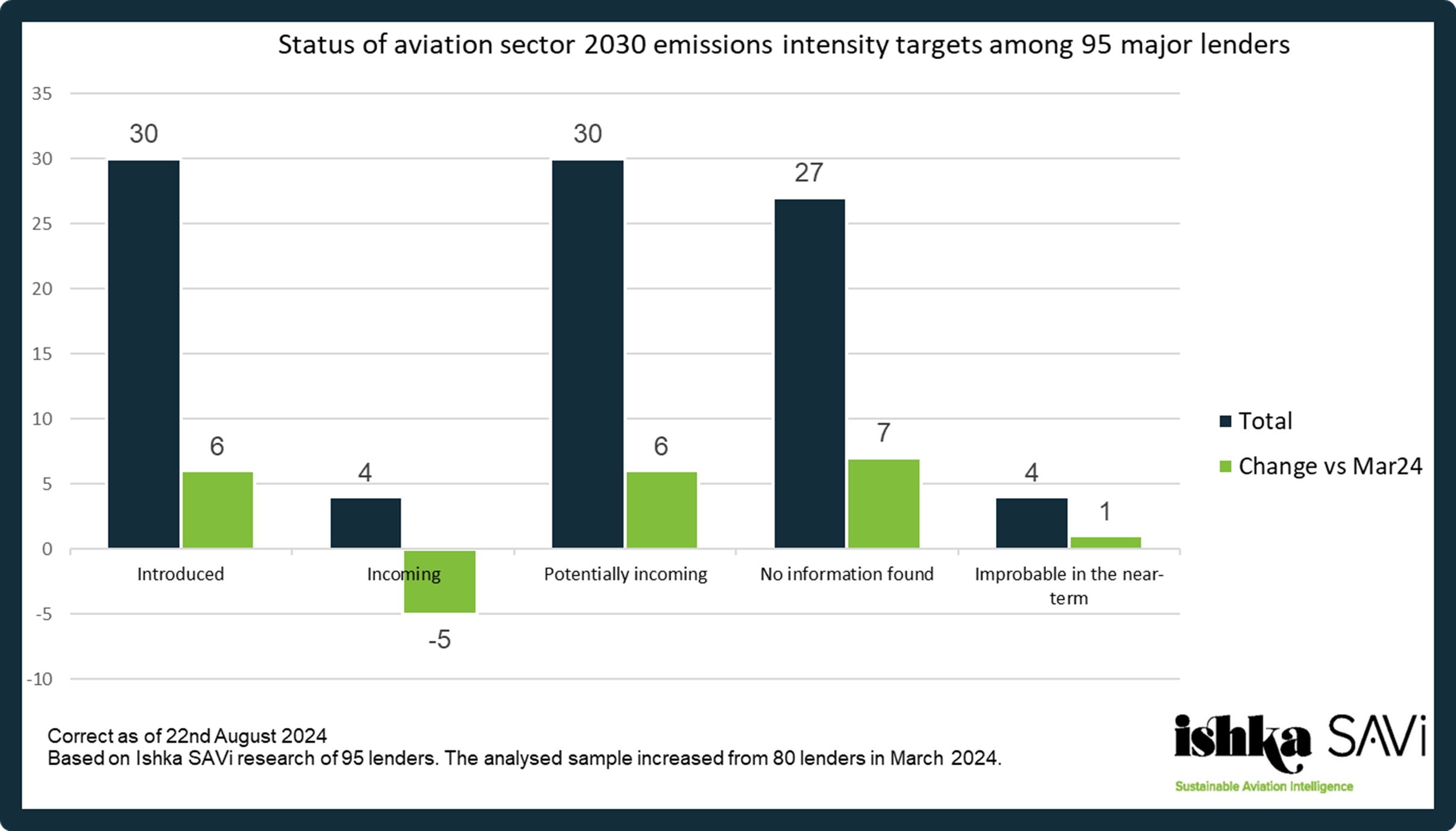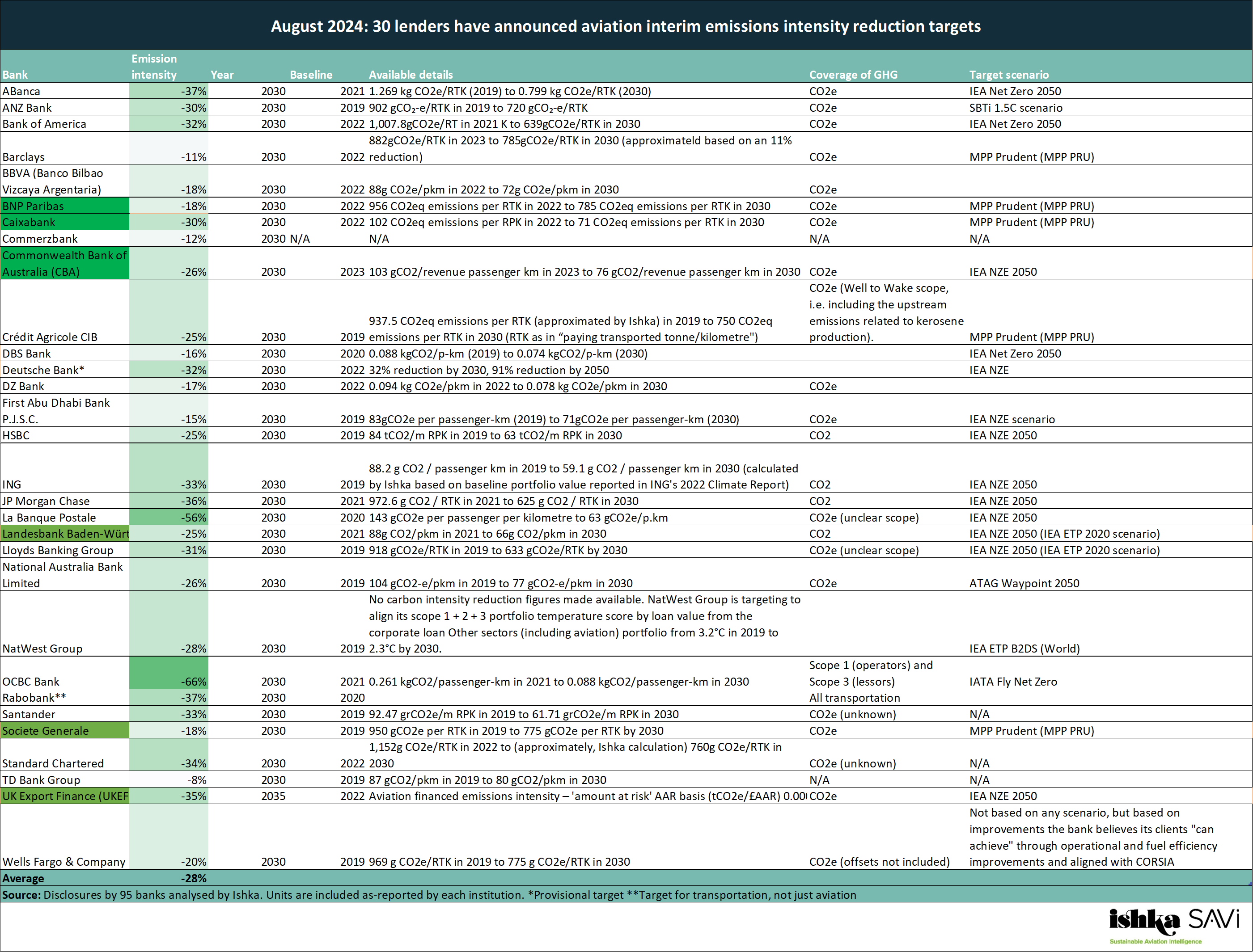As many as 30 banks have now set aviation emissions intensity targets, and at least a further four are expected to announce aviation targets soon, according to Ishka SAVi’s latest analysis of aviation financed emissions (the GHG emissions linked to the investment and lending activities of financial institutions). The findings are the result of Ishka’s analysis of 95 global banks and their sustainability reporting – 15 more than the sample analysed in March 2024 and 15 more than the sample analysed in July 2023. Since the last update, Ishka has identified six new lenders with aviation emissions intensity targets, all of which were unveiled in the past six months.
The 30 banks with aviation decarbonisation targets are aiming to reduce the emissions intensity for their aviation lending portfolio by an average of -28% by 2030 versus 2019 to 2023 baselines. As highlighted in prior research, how banks define emissions intensity for aviation varies both in the emissions captured (CO2, various definitions of CO2e, and various scopes) and in the capacity measurements used (revenue passenger kilometre, revenue tonne kilometre, passenger kilometre, etc…).
Regardless, if double-digit percentage reductions in emissions intensity until the end of the decade are to be met, lenders will need to be selective not just in what asset types they finance, but also their associated operators, aircraft configurations and utilisation – from SAF usage to how they are operated.
Recap: Why are banks setting emissions intensity targets?
Emissions target-setting for aviation by banks has picked up pace since 2023 as several lenders crossed the 18-month mark since joining the Net-Zero Banking Alliance (NZBA). NZBA membership requires the setting of initial interim 2030 emissions intensity targets for high carbon-intensive sectors relevant to each lender within 18 months of joining the alliance. For many banks, transportation (aviation included) is one of the largest sources of financed emissions and it is one of nine climate-intensive sectors identified by the NZBA.
Even if transportation (including aviation) only accounts for a small portion of a bank’s total lending, its high associated emissions may be enough to warrant target-setting.
How prominent are aviation emissions targets among lenders?
For this third report examining bank emissions intensity disclosure, 95 global banks were analysed (full list available at the end of this report). The sample encompasses institutions with large global footprints, meaningful transportation or aviation exposure, a track record in sustainable finance within aviation, or a combination of the three. Smaller banks with aviation decarbonisation targets (e.g. ABanca, a Spanish lender) are also included to identify first-movers and their aviation targets.
Many of the analysed banks are members of the NZBA, which covers over 130 banks in 41 countries with over 40% of global banking assets. Considering that the 95 institutions analysed by Ishka include some of NZBA’s largest members, in addition to other large non-NZBA member banks, this analysis should cover a representative part of the global banking sector.
 Source: Disclosures by 95 banks analysed by Ishka.
Source: Disclosures by 95 banks analysed by Ishka.
In addition to the 30 banks that have unveiled interim 2030 (and in one case, 2035) emissions intensity sectoral targets for aviation, four banks are currently working on targets for aviation or are expected to update the market soon. Five of the six banks whose aviation targets were unveiled in 2024 had previously been marked as ‘incoming’. A further 30 banks have announced targets for other high-emitting sectors or are likely to do so, and therefore could expand their range of targets to include transportation as well as aviation (‘potentially incoming’).
As some of these 30 banks unveil further targets in the coming months and years, it will become clearer whether transportation, including aviation, ultimately becomes a focus sector. As a result, Ishka expects many lenders to move from ‘potentially incoming’ to ‘improbable in the near term’ in future analysis.
The remaining 27 banks have not provided guidance on whether they plan to set sector-specific emissions intensity targets, including for transportation. Among the banks with no details on emissions intensity targets, one (Iceland’s Íslandsbanki hf.) is instead aiming to reduce the emissions footprint of its loan portfolio (a target that the bank is on course to achieve by way of reducing its aviation exposure).
As Íslandsbanki’s example shows, it is important to note that Ishka’s analysis focuses solely on emissions intensity targets by 2030, not other environmental targets for aviation set by banks. For instance, a number of international lenders are also setting 2050 targets for aviation (DBS Bank, ING, and Woori Financial Group, for instance), pledging not to invest in infrastructure that results in increased air traffic (La Banque Postale), or choosing to support SAF production (Bank of America). Other banks also have criteria limiting the range of assets and ages they can finance (CIC, Maybank),
Emissions intensity targets for aviation announced to date
The ambitiousness of some of these emissions intensity targets (some as large as a -66% or -56% from 2021 or 2020 to 2030) carry a clear message: an increased focus by lenders on best-in-class new technology aircraft with the lowest-possible per-passenger emissions (high seat density, high load factors).
The six banks in green have been added since Ishka’s last update in March 2024. Since July 2023, roughly 12 months ago, this list has doubled with the addition of 16 banks. The latest additions comprise BNP Paribas, Caixabank, Commonwealth Bank of Australia, Landesbank Baden-Württemberg (LBBW), Societe Generale, and UK Export Finance (UKEF). BNP Paribas, Caixabank and Societe Generale are all Pegasus Guidelines signatories and their targets are based on Pegasus’ reference decarbonisation scenario: Mission Possible Partnership (MPP) Prudent scenario. UKEF is currently the only export credit agency (ECA) included in the analysed list of 95 lenders.
 Source: Disclosures by 95 banks analysed by Ishka.
Source: Disclosures by 95 banks analysed by Ishka.
Click here to download the data.
Annual reporting on the progress to meeting these targets over the next few years will be key to track their achievability and, if the banks fail to achieve them, further understand the potential consequences for bank lending into the sector.
As noted earlier this year, few banks have yet disclosed progress on aviation emissions intensity targets. One example of a bank yet to make substantial progress is BBVA, which noted that its 2023 aviation portfolio's emissions intensity was up 1% compared to the 2022 baseline year (89g CO2e/pkm in 2023) although the bank notes it "remains below the market average." On the other hand, ANZ says it is on track to meet its -30% by 2030 target with 2023 emissions intensity of 828 gCO₂/RTK, lower than its 2019 baseline of 902 gCO₂-e/RTK.
The Ishka View
With an increase from 14 to 30 lenders since July 2023, Ishka’s prediction that the number of banks with aviation targets would double over the past 12 months proved correct. The launch of the Pegasus Guidelines in April allowed three more lenders to establish targets. It remains to be seen whether more lenders will adopt the guidelines in their setting of aviation emissions intensity targets. In the next 12 months, Ishka expects a smaller number of banks to set aviation decarbonisation targets. Although the number of banks who have yet to set transportation targets – or any emissions intensity targets at all – remains large, the clearest motivator so far has been a combination of NZBA membership and a sizeable aviation lending book relative to other sectors. Most of the banks that fall into that category have already set targets. Nevertheless, with scrutiny over financed emissions still growing, more banks are likely to set targets for aviation financed emissions.
Ishka will continue to monitor the progress of banks in setting and managing decarbonisation targets for aviation. If your institution is missing from the list below or you believe other banks should be included, please get in touch savi@ishkaglobal.com
The 95 banks analysed by Ishka comprise: ABanca, ABN AMRO BANK N.V., Agricultural Bank of China (ABC), AIB Group Plc, Australia & New Zealand Banking Group Limited (ANZ), Bank of America, Bank of China, Bank of Communications (BOCOM), Bank of Kyoto, Barclays, Bayern LB, BBVA (Banco Bilbao Vizcaya Argentaria), BMO Financial Group, BNP Paribas, Caixabank, Chiba Bank, China CITIC Bank, China Construction Bank (CCB), China Development Bank (CDB), China Everbright Bank, China Guangfa Bank, China Merchants Bank, China Minsheng Bank, CIC, CIMB Bank Berhad, Citi, Commerzbank, Commonwealth Bank of Australia, Crédit Agricole CIB, Crédit Mutuel Group, Daiwa Securities Group, DBS Bank, Deutsche Bank, Development Bank of Japan (DBJ), DNB (DnB NOR Bank ASA), DZ Bank, E.SUN Commercial Bank, Erste Group Bank AG, First Abu Dhabi Bank P.J.S.C., Goldman Sachs, Haitong Securities, Hana Financial Group, Helaba, HSBC, Huatai Securities, ICBC (Industrial and Commercial Bank of China), ING, Intesa Sanpaolo, Investec, ÍSlandsbanki hf., JP Morgan Chase, KB Financial Group Inc., KfW IPEX-Bank, Korea Development Bank, La Banque Postale, Landesbank Baden-Württemberg (LBBW), Lloyds Banking Group, Macquarie Group, Maybank, Mizuho Financial Group, Morgan Stanley, MUFG Bank (Mitsubishi UFJ Financial Group), Nanto Bank, National Australia Bank Limited, National Bank of Canada, Natixis Corporate and Investment Banking, NatWest Group, Nishi-Nippon City Bank, Nomura Holdings, Inc., Nord LB, Nordea Bank Abp, OCBC Bank, Ping An Bank, PNC Financial Services, Rabobank, Reichmuth & Co Privatbankiers, Royal Bank of Canada, Santander Group, Scotiabank, Shanghai Pudong Development Bank, Skandinaviska Enskilda Banken (SEB), Societe Generale, Standard Chartered, Sumitomo Mitsui Financial Group, Inc. (SMFG), Sumitomo Mitsui Trust Holdings, Inc., Swedbank AB, TD Bank Group, The Bank of East Asia, Türkiye İş Bankası A.Ş. (Işbank), UBS AG, UK Export Finance (UKEF), UniCredit, UOB, Wells Fargo & Company, and WOORI FINANCIAL GROUP.



